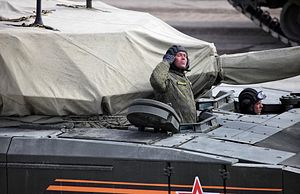The Russian Ministry of Defense’s (MoD) Armata program, a universal chassis system that is intended to be the foundational element for Russia’s future armor force and includes the third-generation T-14 main battle tank (MBT), could be in danger of being scrapped, following recent MoD announcements to upgrade T-80 and T-90 series main battle tanks (MBTs) in addition to revising plans to melt down 10,000 armored vehicles by 2020.
These announcements “together with the reduction in potential orders for the T-14 MBT and the continued decline in Russian defense spending have led some sources to claim that the Armata program has been cancelled,” IHS Jane’s Defense Weekly reported back in September. In detail, the MoD announced that it will melt down 4,000 armored vehicles and retain the remaining 6,000 as a strategic reserve. Earlier this year, the MoD also awarded a $417 million contract to upgrade T-80 and T-90 MBTs to modern standards.
T-80 tanks will receive an armor upgrade, next to a host of other modifications, whereas T-90s will be retrofitted with technology found in the T-14 MBT including a new automatic target tracker and fire control computer as well as a remotely operated weapon station. As I reported in January, the Russian MoD also announced plans to upgrade the ground forces existing stock of T-72 MBTs.
“Russia’s operates around 300 T-72B3s, an upgraded variant of the original Soviet-era T-72 MBT, out of a total T-72 force of roughly 1,900, and around 350 advanced T-90A, and T-90SM, (other designations T-90AM or T-90MS), the latest and most modern version of the T-90, specifically designed for export,” I reported. Around 450 T-80 MBTs are currently in service with the Russian Army. Already in January I speculated that the upgrade announcements could imply trouble in the Armata program:
The Russian Ministry of Defense’s decision to upgrade older T-72 and T-90 models could be interpreted as a sign that despite earlier announcements, the T-14 will not replace the Soviet-era tanks as the mainstay of Russia’s tank force in the near future and that the Russian Ground Forces will continue to operate various MBT variants at least for the next decade. As I reported elsewhere (See: “Russia’s Military to Receive 100 New T-14 Armata Battle Tanks”), the Russian defense ministry concluded a contract with Uralvagonzavod (UVZ) for the first batch of 100 T-14 MBTs only in September 2016.
The Russian Ground Forces are expected to receive up to 100 third-generation T-14 main battle tanks (MBT), by 2020, Russian Deputy Defense Minister Yury Borisov said in August. (Initially, Russia planned to procure 2,300 T-14s by 2025.) “Borisov’s statement is (…) most likely meant to exert public pressure on the Russian defense industry to accelerate work on the new MBT,” I wrote in August. “ [T]here are signs that the Russian government is not happy with the progress of the T-14 program and the tank’s manufacture (…).” Among other things, senior Russian defense officials have repeatedly publicly visited UVZ over the last months, which traditionally indicates the Kremlin’s displeasure with a weapons program.
































